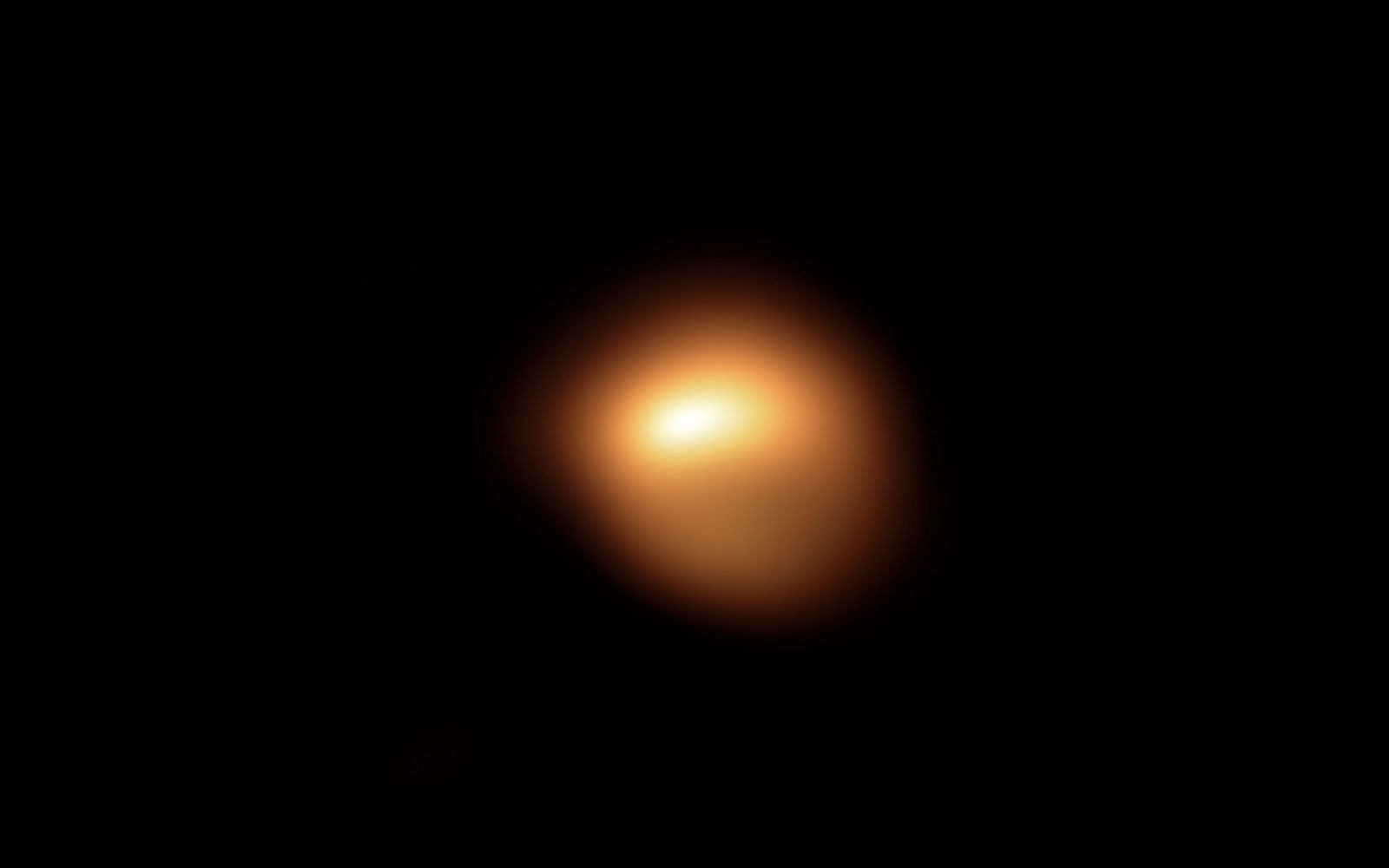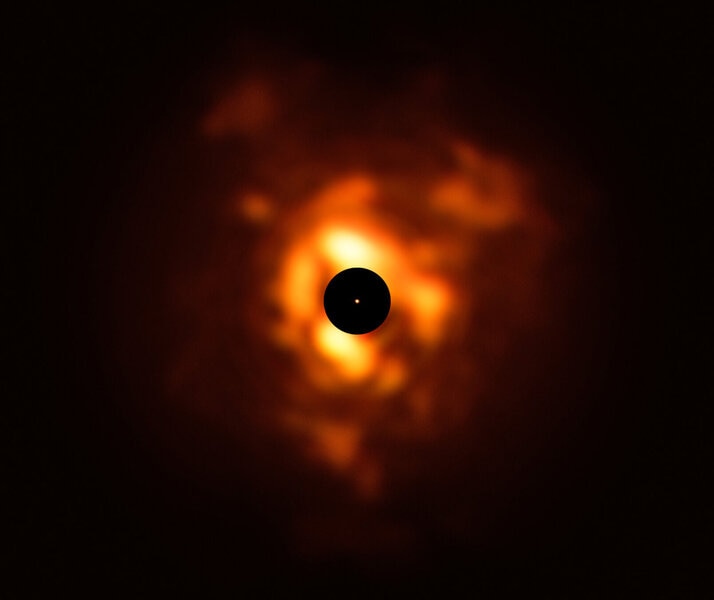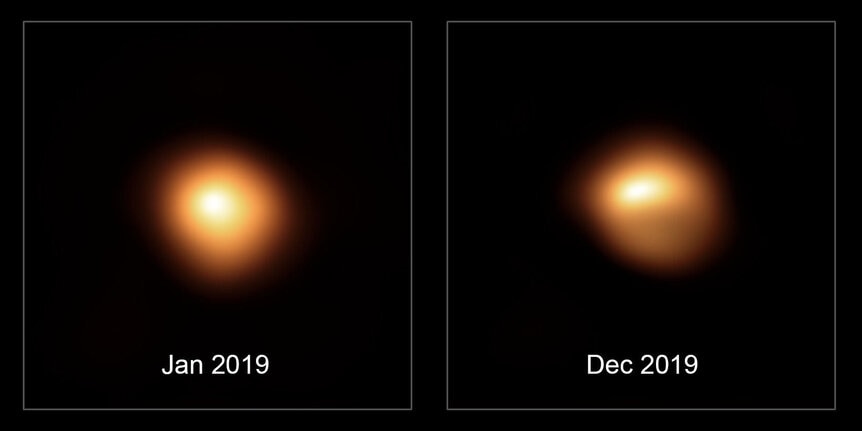Create a free profile to get unlimited access to exclusive videos, sweepstakes, and more!
Betelgeuse's shenanigans just got weirder: Only *part* of it is dimming

What the heck is Betelgeuse doing?
The red supergiant star marking the constellation Orion's right shoulder is one of the most famous in the sky (at least one supernatural comedy movie has, I admit, helped); for one thing it's a ruddy color that stands out from most other stars, and for another it's one of the brightest stars in the sky.
Usually, it's the 11th brightest star. But it's been dimming substantially over the past couple of months, and given its current status it's now tied for 24th. That's quite a fall!
This has prompted a lot of discussion about it possibly exploding as a supernova, but that's extremely unlikely for now*. Our best estimate is that it won't explode for another 100,000 years, so don't hold your breath.
But then why is it dimming? We know it's a variable star, changing its brightness up and down by a small percentage over time, usually on a roughly 420-day cycle. This due to the way the upper atmosphere of the bloated star traps light and heat, changing its size and brightness, which is common for red supergiants. It's likely this is a more extreme version of that.
To try to find to more about what's going on with Betelgeuse, in December 2019 astronomers took a look at the mighty star using the also-mighty Very Large Telescope equipped with the ridiculously phenomenal SPHERE camera, which is capable of extremely high-resolution images. What it saw, frankly, made me gasp out loud when I saw it:
That is literally an image of Betelgeuse showing its shape and brightness!
Coooooooool.
But what the WHAT? We knew it was dimming, but from this image you can see that only part of it is dim. The upper part is bright, but the lower part is significantly dimmer! Why?
Well, no one is quite sure. Betelgeuse isn't like the Sun. It's a massive red supergiant, and it's pretty weird even when it's not dropping like a stone in brightness.
For one thing, stars like that have a very deep convective layer, a part of their atmosphere where hot gas rises and cooler gas sinks. These can have magnetic fields embedded in them, which can get tangled up together, interfering with the usual convective process. Sometimes these packets of hot gas rise, get to the surface, cool and darken, but then have trouble sinking back down due to the magnetic fields.
When that happens the surface gets dark spots on it — on the Sun we call these sunspots. The Sun's spots are usually pretty small, but on Betelgeuse they can be enormous, sometimes covering a significant fraction of the surface. It's possible that the dimmer part in the image is covered with these huge cooler regions.
In fact, the temperature of Betelgeuse can be measured. It's usually cooler than the Sun (about 3,300° C versus 5,500° for the Sun), but it has apparently cooled a bit recently, dropping by roughly 100°C. It could be these spots are even cooler than that, but when they're averaged in with the rest of the star we get that 100° drop.
The fact that it's cooler dims it as well, since cooler objects emit less light. On top of that it may be that it is physically smaller than usual, too, and may be now roughly 90% its usual diameter. With less surface area to emit light, that makes it dimmer as well.
It also blows a stellar wind (again, like the Sun's solar wind) that sometimes contains a lot of dust — images taken in the infrared in 2011 show it's surrounded by a vast cloud far larger than our solar system that's rich in things like silica and alumina. A new image taken in December 2019 shows the same thing. This dust almost certainly contains carbon molecules that are very dark and absorb light. If it blew out a cloud of that material it could cover part of the star, causing the dimming.
Or just exaggerating it. Like I said, it's known to be a variable star, so we're possibly seeing its normal dimming exacerbated by some other phenomenon.
This video shows Betelgeuse in January 2019 versus December of that same year:
Interestingly, it looks as if the shape of the star has changed, too. That's certainly possible! Betelgeuse is so huge — something like 1.2 billion kilometers across, compared to the Sun's 1.4 million — that even though it's 20 times the mass of the Sun, it's incredibly low density. It doesn't have a surface so much as a wispy fog that just fades away with height. A particularly hot plume coming up from the interior can puff that part of the star outward, just as a particularly cool spot might shrink it. It sometimes ejects huge clouds of gas as well.
It's important to note that you have to be careful when looking at images like that, though. A brighter spot near the edge (like at the upper left) can make it look like there's a huge bump there, when really you're just seeing the glow from the spot distorting the apparent shape (we saw a similar thing when the New Horizons probe approached Pluto, making that icy world look lumpy even though it's pretty spherical). So I don't want to overinterpret the image, except that obviously some parts of the star are way brighter than others.
So what's next? Well, it's hard to say. Betelgeuse may dim more, though historically it does go up and down, and we're nearing the bottom of its usual 420-day periodic downswing. Stars do what they're gonna do, so we'll have to wait and see if it continues dimming, or starts to recoup. You can follow Betelbot on Twitter to see updates, and if I hear anything more, you can bet I'll be writing about it.
I still don't think it will explode any time soon, either, but that doesn't make this any less interesting.
One of the brightest stars in the sky, one over a billion kilometers across, has dramatically dimmed, noticeable to the naked eye, and even with state-of-the-art images of its actual disk we can't be sure why.
That's pretty dang interesting.
*I see a lot of articles with breathless headlines speculating that it might be about to explode, but then when you read the article they interview a beleaguered astronomer saying no, it won't. The front of my forehead is flat from banging it on my desk every time I see something like this.





























